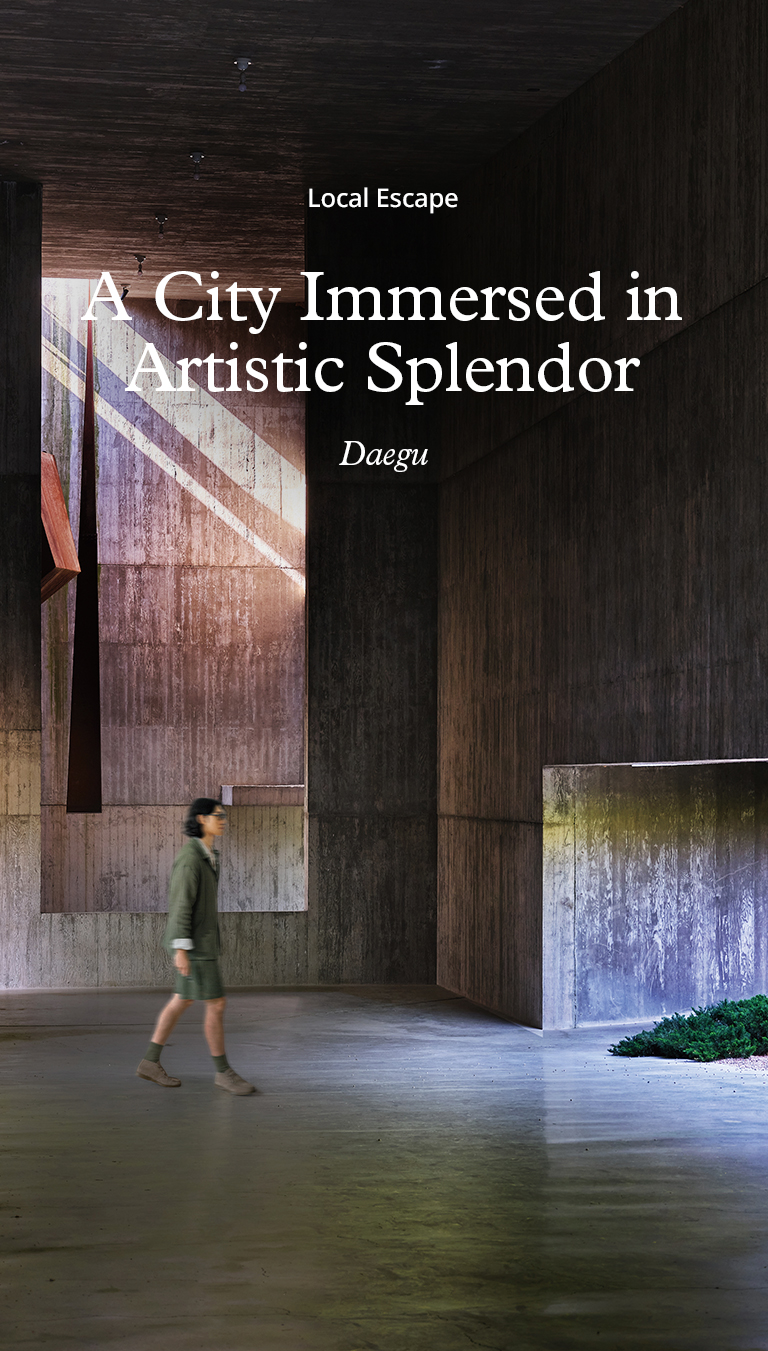
Daegu, with its tall and spacious buildings, markets both large and small, and the constant gathering and dispersing of people and cars, is always full of vitality. At the beginning of summer, bursting with life, Koreans board trains and cars to enjoy art. They head to Daegu—a place brimming with art, including architecture, landscaping, antiques and opera.
Writer. Yeo Ji Hyo
In Daegu, you’ll find Sayuwon—a name that means “Garden of Contemplation.” Here, there’s no need to search for art—everything is art. Visitors need only step inside to experience it.
First, one must explore. Across the entrance stretches a mountain garden of 700,000 square meters, filled with trees and stones that have endured for decades or centuries, forming pathways. Buildings designed by world-renowned architects await visitors.
Past the entrance, you first encounter Soyoheon Art Pavilion. This building, designed by Alvaro Siza—often called “the architects’ architect”—to display Picasso’s “Guernica” and “Pregnant Woman,” stands proudly in Korea. The V-shaped concrete structure resembles a cave with no doors or windows. Whether due to its unique shape or scale, it overwhelms emotions upon the very sight of it.
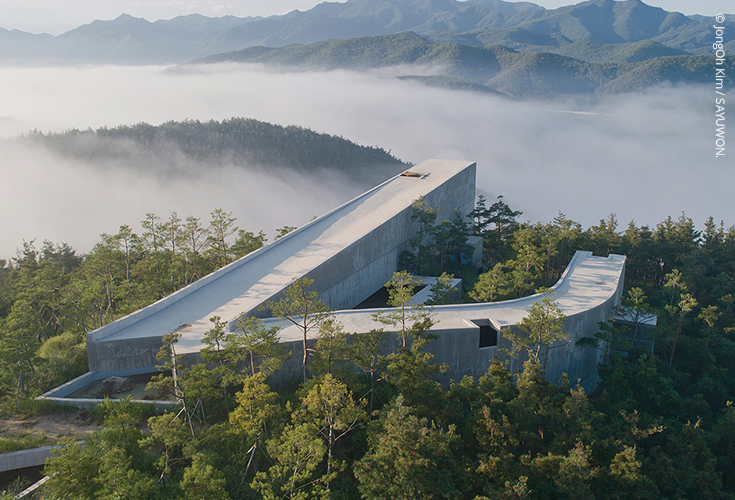 Soyoheon, designed by Alvaro Siza
Soyoheon, designed by Alvaro Siza Myeongjeong, designed by Seung Hyo-Sang
Myeongjeong, designed by Seung Hyo-Sang
Inside Soyoheon, you find light and shadow, straight and curved corridors and a courtyard made of stone and moss. The straight corridor ends at a bronze sculpture symbolizing death, while another corridor leads to an egg sculpture representing birth. Footsteps echo continuously. As you walk and listen, complex emotions empty out. While you move between the paths of death and birth, thoughts about your presence here gradually emerge. You feel the profound energy of the space.
Opposite Soyoheon rises Miradouro Sodae, also designed by Alvaro Siza, resembling a bird’s nest. Climbing the stairs, through large windowless openings, you see Palgongsan Mountain’s ridgeline and all directions of Sayuwon becoming one with the view.
The sense of contemplation intensifies in the vast garden beyond. The scenery of Byeolyu Dongcheon with its 200-year-old crape myrtle and Pungseol Gicheonyeon with its 108 quince trees is unforgettable. Is this the essence of landscape art? The quince trees, averaging over 300 years old (the oldest being 655 years), display beautiful forms as if emerging from an ink painting. Imagining these trees bearing fruit for centuries and the people who treasured them evokes a sense of sublimity.
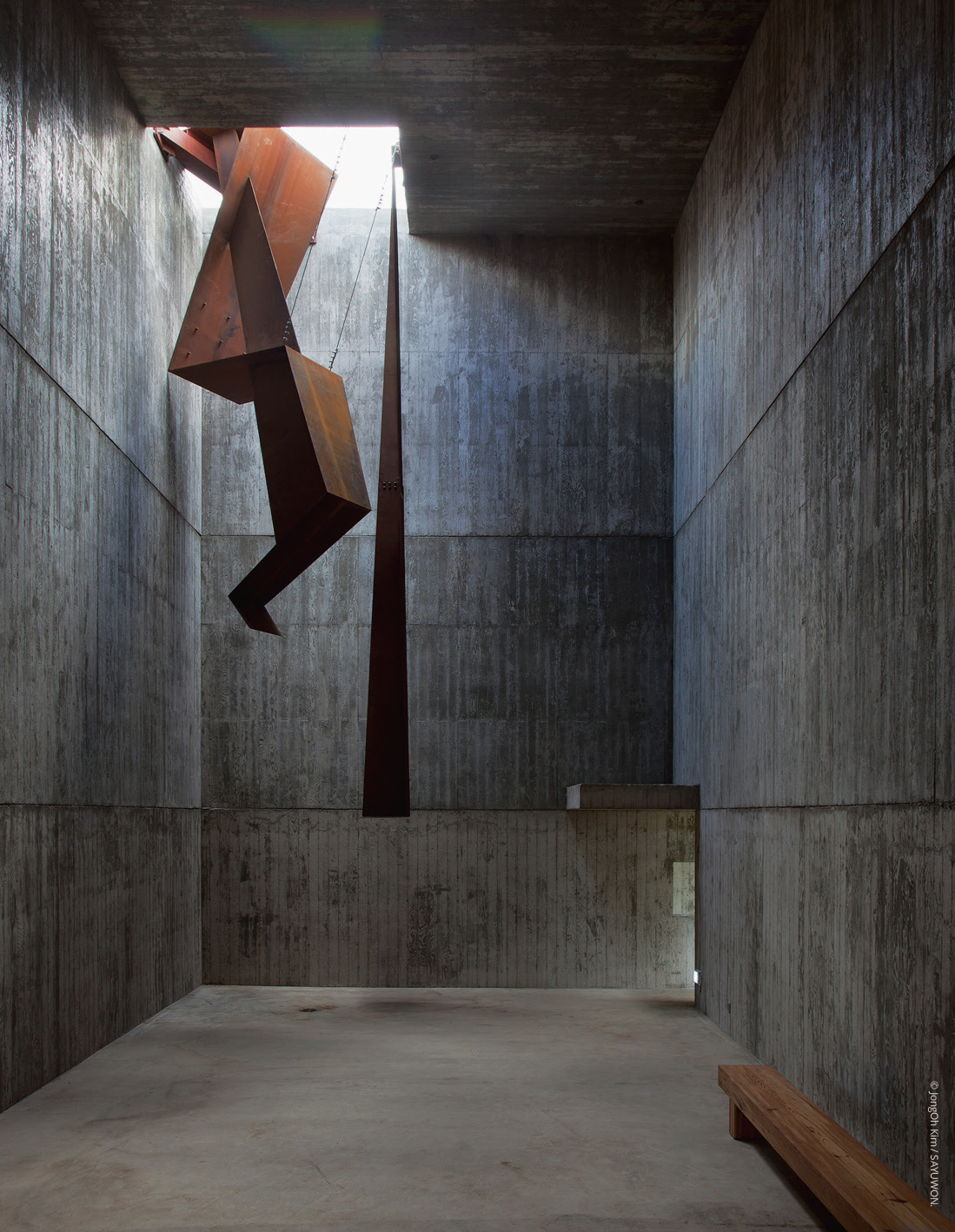 Soyoheon, designed by Alvaro Siza
Soyoheon, designed by Alvaro Siza
At Myeongjeong, the highest point in Sayuwon, exists another enlightenment. Inside this building designed by leading Korean architect Seung Hyo-Sang, narrow, maze-like corridors extend. Finally, the blue sky appears with water flowing down walls and a red wall on the opposite side—a view unimaginable from outside. Though at the highest point, it doesn’t look down on the ground but instead becomes the lowest position, gazing only at the high sky. People immersed in the space slow their steps, perhaps because each has discovered something meaningful to themselves.
Every space in Sayuwon—the small house Hyeonam, the Korean garden Yuwon, the chapel Naesim Nakwon, the monastery Wasa—was born of contemplation. Even the smallest space has a name; every rock and tree has a story. It’s a place infused with meticulous care. Perhaps due to the power of concentrated art and devotion, even a chance breeze becomes meaningful.
Leaving Sayuwon, it’s now possible to understand the power of nature, landscape, architecture and art. These forces enabled both emptying and filling of the mind. This place is clearly a space that didn’t exist before.
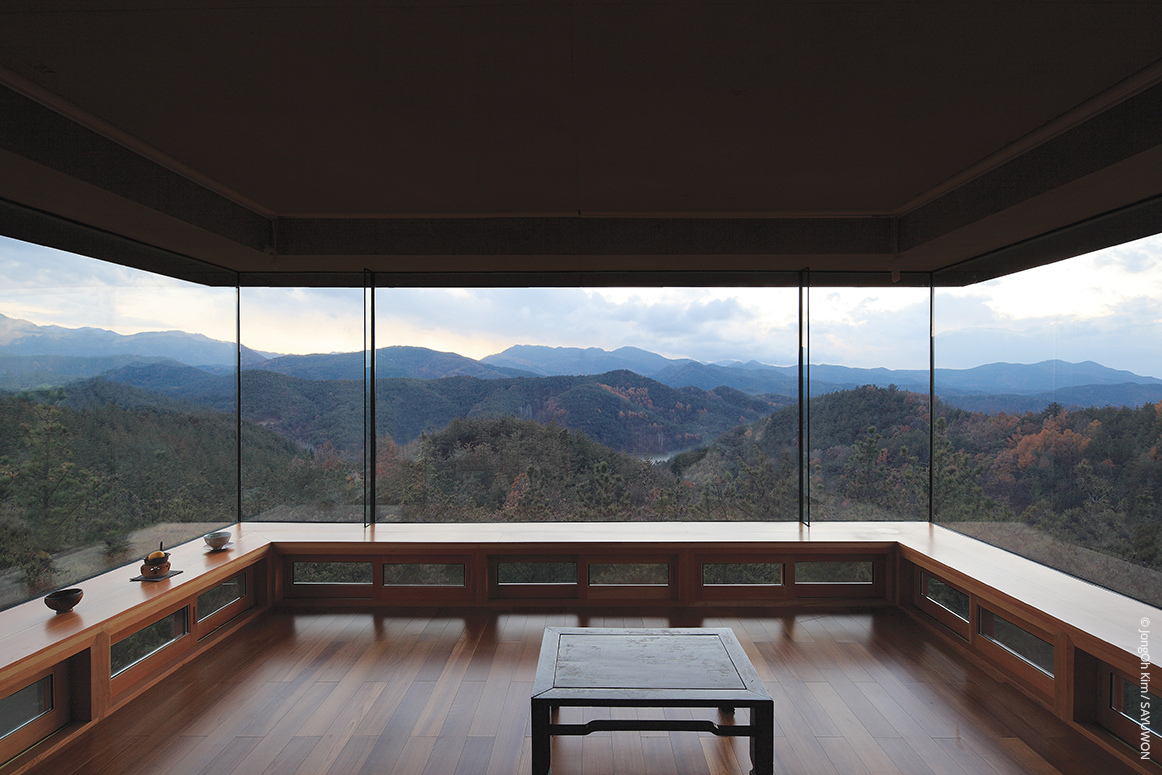 Sayuwon’s Hyeonam serves as a teahouse.
Sayuwon’s Hyeonam serves as a teahouse.
대구에 도착해 사유원을 찾았다. 사유하는 정원이란 뜻의 이곳에선 예술이란 단어를 찾아 나설 필요가 없다. 이곳의 모든 것들이 예술이므로 방문객은 그저 그 안으로 발을 들이기만 하면 된다. 입구 건너 펼쳐진 70만 m2의 산속 정원에는 수십~수백 년을 버텨온 온갖 나무와 돌들이 길을 이루고 세계적 건축가들이 설계한 건물이 기다린다.
입구를 지나 새의 둥지, 소대를 만난다. 건축가들의 건축가라 불리는 알바로 시자가 설계했다. 새들이 주변을 배회하고 있는 이 건물은 산을 향해 인사하듯 15도가량 기울었다. 계단을 오르면 유리 없는 커다란 창으로 사유원의 동서남북이 눈에 들어온다.
팔공산의 능선과 하나 된 정원의 모습을 훑다 보면 건너편의 소요헌이 걸린다. 피카소의 게르니카와 임신한 여인을 전시하기 위해 설계된 이 건물이, 한국 위에 우뚝 섰다. V자 모양의 콘크리트 건물은 출입문도 없고 유리창도 없는 동굴 같다. 그 특이한 모양 때문인지, 규모 때문인지 바라보는 것만으로도 감정을 압도한다.
소요헌 안으로 들어서면 빛의 음영과 직선형 복도와 곡선형 복도, 돌과 이끼로 만든 중정이 있다. 직선 복도의 끝은 죽음을 의미하는 청동 조형, 다른 복도의 끝은 탄생을 의미하는 알 조각에 닿는다. 발소리가 끊임없이 울려 퍼진다. 거닐면 거닐수록, 소리에 귀 기울일수록 복잡한 감정은 비워진다. 죽음과 탄생에 이르는 길을 오가며 차차 이곳에 있는 자신에 대한 생각이 스며나온다. 공간의 힘이 느껴진다.
그 감각은 이어지는 커다란 정원에 들어서면 극대화된다. 200년 된 배롱나무가 숨쉬는 별동유천, 모과나무 108그루가 있는 풍설기천년의 정경은 잊으려야 잊을 수 없다. 조경 예술의 정수란 이런 것일까. 평균 300년 이상, 최장 655년 된 모과나무들은 수묵화 작품에서 솟아난 듯, 아름다운 수형을 자랑한다. 수백 년이 지나도 여전히 과실을 맺는 나무들, 이를 소중히 지켜온 사람들의 모습을 상상하면 숭고함마저 느껴진다.
사유원에서 가장 높은 곳에 있는 명정에도 어떤 깨달음이 존재한다. 한국 대표 건축가 승효상이 디자인한 이 건물 안에 들어서면 좁고 긴 미로 같은 복도가 이어진다. 마침내 파란하늘과 벽을 타고 흐르는 물, 그리고 반대편에 붉은 벽이 나타난다. 바깥에서는 상상할 수 없던 모습이다. 가장 높은 곳에 있지만 땅을 내려다보지 않는다. 다시 가장 낮은 위치가 되어 높은 하늘만을 바라본다. 공간에 젖어든 사람들의 발걸음이 느려진다. 각자 자신에게 의미 있는 무언가를 발견했기 때문이리라.작은 집 현암, 한국식 정원 유원, 채플 내심 낙원, 수도원 와사 등 사유원에는 사유 없이 탄생한 공간은 없다. 작은 공간 하나에도 이름이 있고, 바위 하나 나무 하나에도 사연이 있다. 치밀한 정성이 스민 곳이다. 밀도 높은 예술과 정성의 힘 때문일까. 어쩌다 맞이하는 한 자락의 바람마저 의미가 되어 다가온다.
After appreciating the grand works of nature and architecture, visitors can head to see the essence of traditional Korean art. About 50 minutes by car from Sayuwon, driving south in Daegu, one finds Kansong Art Museum Daegu. This is a branch of Kansong Art Museum, Korea’s first private art museum, which opened in 2024 after about nine years of preparation.
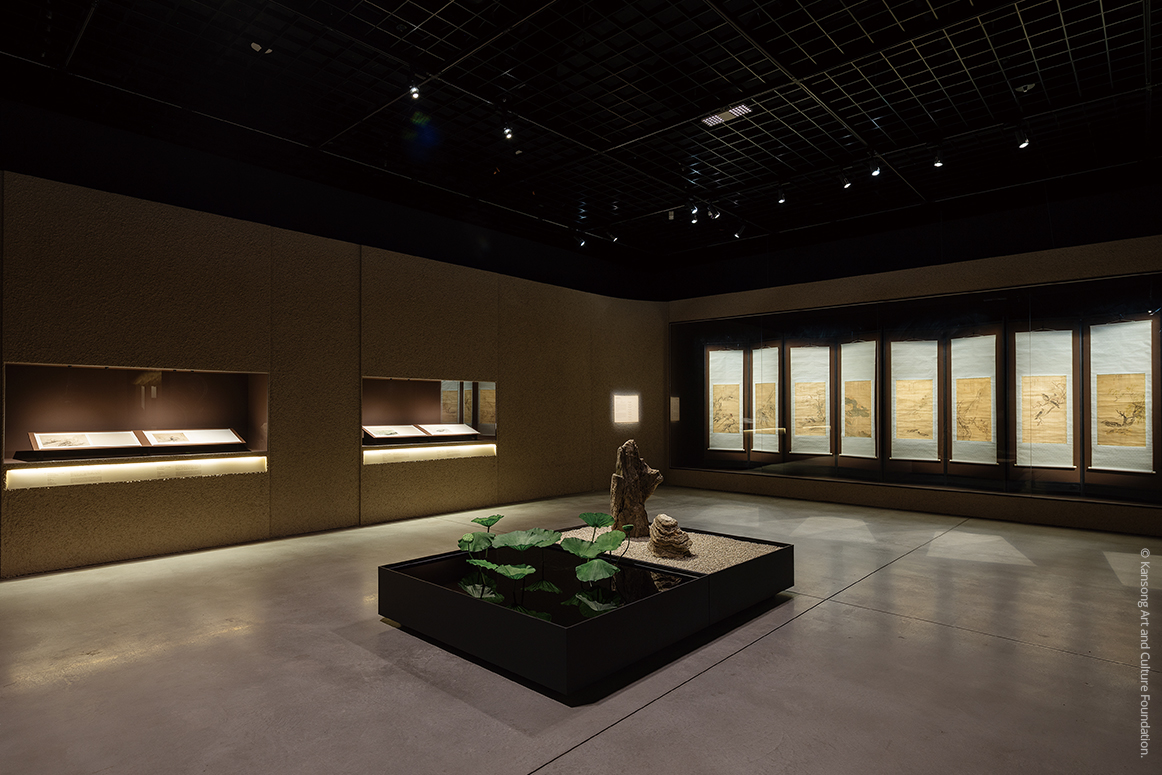 “The Sense of Beauty within Bird and Flower Paintings” exhibition at Kansong Art Museum Daegu
“The Sense of Beauty within Bird and Flower Paintings” exhibition at Kansong Art Museum Daegu
Korea’s notable treasures and artworks in the Kansong collection can be seen here. The museum has four exhibition halls and a visible restoration room on the first floor, and two more exhibition halls on the lower level.
While the viewing order doesn’t matter, nothing should be missed since the exhibits rotate every three months to preserve their condition. However, if one wonders where to start, “The Sense of Beauty within Bird and Flower Paintings” is recommended. This special exhibition features elegant works centered on flowers and birds, created between the 16th and 19th centuries. It offers a glimpse into how Koreans of the past viewed these small creatures that enrich life. Through delicate depictions of flora and fauna, visitors can experience the unique aesthetics of Joseon-era bird-and-flower paintings while reflecting on the small beings around us.
The permanent exhibition, centered on ceramics, should not be missed either. It features two national treasures that represent Joseon white porcelain and Goryeo celadon. Walking around and taking in their beauty, along with accompanying pieces such as calligraphy, genre paintings and landscape paintings, is ideal for satisfying artistic thirst. For those seeking dynamic works, The Flow, a media art piece created using items from the Kansong collection, offers an engaging and informative experience through a 38-meter screen.
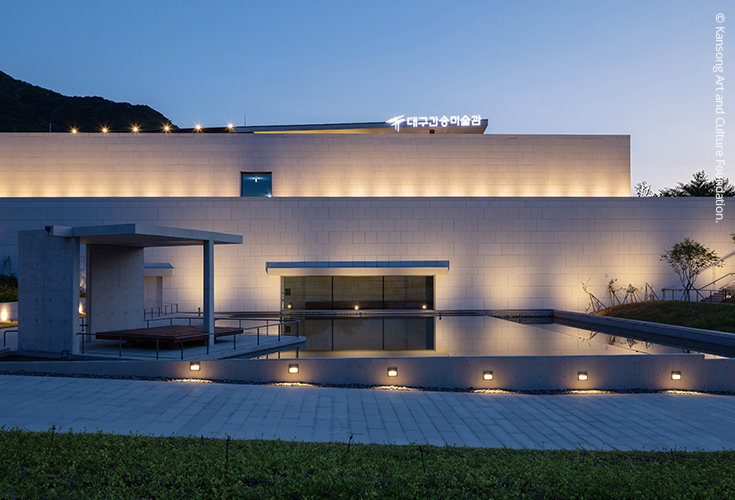 Night view of Kansong Art Museum Daegu
Night view of Kansong Art Museum Daegu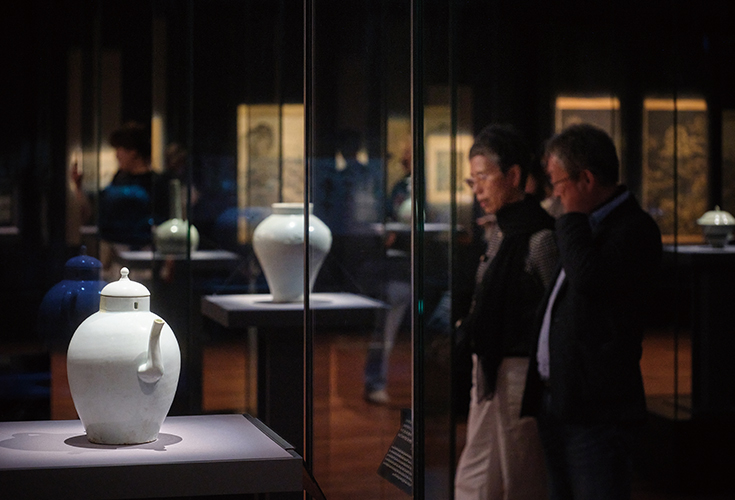 Visitors viewing ceramic artifacts in the permanent exhibition at Kansong Art Museum Daegu
Visitors viewing ceramic artifacts in the permanent exhibition at Kansong Art Museum Daegu
자연과 건축이라는 거대한 작품을 감상한 뒤, 한국 전통문화의 정수를 만나러 간다. 사유원에서 차로 약 50분, 대구 남쪽을 향해 달려 대구간송미술관을 찾았다. 한국 최초의 사립 미술관인 간송미술관의 분관으로, 약 9년을 준비해 2024년에 공개된 곳이다.
1층에 네 개의 전시실과 보이는 수리복원실, 지하 1층에는 두 개의 전시실이 있다. 관람 순서는 상관없지만, 빠뜨려야 할 것은 없다. 전시품의 상태를 보존하기 위해 3개월마다 전시품이 교체되기 때문. 무엇부터 보아야 할지 고민된다면, 먼저 ‘화조미감’전을 추천한다. 해당 전시는 꽃과 새를 주제로 한, 단아한 멋이 배어나는 작품들이 있는 기획전이다. 16세기에서 19세기 제작된 화조화를 통해, 과거 한국인들이 그것들을 어떤 시선으로 바라보았는지 추측하게 한다. 삶을 풍요롭게 만드는 작은 생물들을 섬세하게 표현한 작품들을 통해, 조선시대 화조화만의 고유한 미감을 즐기는 동시에 일상 속 작은 존재에 대해서도 다시 생각해 볼 기회를 가지게 될 것이다.
도자가 중심이 되는 상설전에는 조선백자와 고려청자를 대표하는 국보 두 개가 기다리고 있다. 사방을 돌며 그 아름다움을 감상하고, 함께 전시된 서예, 풍속화, 산수화를 함께 눈에 담으며 예술적 갈증을 채우기에 좋다. 역동적인 작품을 보고 싶다면, 간송미술관의 소장품으로 만든 미디어 아트 The Flow를 감상하자. 38 m 스크린을 통해 작품을 감상하며 대구간송미술관에서 흥미롭고 유익한 시간을 보낸다.
One of the key forces behind Daegu’s emergence as a city of arts is the Daegu Opera House, which opened in 2003. Since its debut, it has been beloved by art enthusiasts for its diverse opera performances, enriching artistic programs and comfortable facilities.
Under the glass building reminiscent of a grand piano, opera performances—a comprehensive art form combining music, dance and costumes—continue without interruption. The Daegu Opera House regularly stages its own productions, which have earned international acclaim for their artistic merit, alongside a variety of planned domestic and international guest performances.
Performances here are deeply satisfying thanks to facilities that allow each work to be properly appreciated. Its 1,602 horseshoe-shaped seats offer an unobstructed view from every angle, and the acoustics are superb. Thanks to this audience-friendly layout, even those new to opera can enjoy a performance with ease. With the Daegu International Opera Festival bringing world-renowned artists to its stage each year, the Daegu Opera House has become a cultural landmark well worth visiting during your travels.
 Performance at Daegu Opera House
Performance at Daegu Opera House
대구를 예술의 도시로 만든 주역 중 하나는 2003년 개관한 대구오페라하우스였다. 개관 이래, 다양한 오페라 공연 및 유익한 예술 프로그램, 쾌적한 공연 시설로 예술 애호가들의 사랑을 받아왔다.
그랜드 피아노를 연상시키는 유리 건물 아래, 음악과 무용, 의상까지 종합예술이라 불리는 오페라 공연이 끊임없이 이어진다. 대구오페라하우스는 해외에 진출하여 작품성을 인정받은 자체 제작 공연과 국내외 유수의 기획 공연을 정기적으로 선보인다.
작품을 제대로 감상할 수 있는 시설도 갖췄다. 말발굽 형태로 설계된 1,602석의 객석은 어느 좌석에서도 탁 트인 시야를 제공한다. 음향 역시 수준급이다. 관객 친화적인 구조 덕분에 오페라 입문자도 부담 없이 공연을 즐길 수 있다. 세계적인 예술가들이 참여하는 대구국제오페라축제가 매해 열리기에, 이곳은 여행 중 들를 만한 문화 명소로 손꼽힌다.